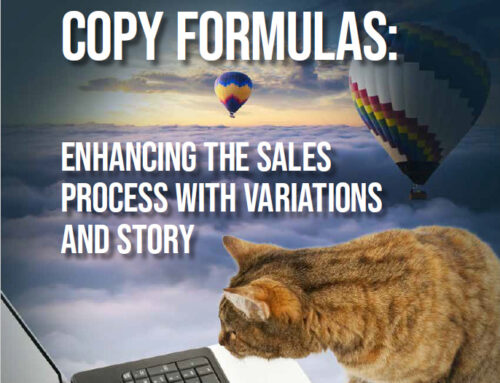Not giving your copy enough attention? Why not switch things up and test some new additions that might keep the persuasiveness of your message from going missing . . .
Enhance Your Sales Message with These 6 Persuasive Additions
What “tweaks” could you make or suggest to your messaging to make it more persuasive?
In Part 1 of “Creating the Right Copy Strategy to Appeal to Your Audience,” we talked about using the Sales Process as an overall messaging guide.
The Sales Process follows the Pain/Pleasure, Solution, Benefits, Offer, Credibility, Close formula.
Within that general copy formula, there are many variations of the Sales Process – each adding an interesting component to your messaging that can make a significant difference in results.
Here’s how and when you might incorporate these variation components to boost the power of your sales message.
Could you make the prospect really experience the pain?
Maybe your prospects are putting off addressing a particular pain – or they don’t understand the implications of waiting.
In these cases, you can create really powerful messaging by “prolonging” the pain discussion. You want to agitate the pain the prospect may be feeling.
In this messaging strategy, you make the prospect remember how the pain feels, make the prospect experience it, point out the implications of the pain – so prospects become highly motivated to solve it.
“Is your bank falling behind digitally? Are your Relationship Managers losing deals because they can’t respond quickly? And is your margin suffering while you struggle to stay competitive?”
There’s one consultant now who has found great success with agitating the pain in the email conversion series. His 3-email plan focuses on making the prospect feel and experience the different elements of the pain.
Maybe your prospects don’t really recognize the problem . . .
Do you need to describe the problem to your prospects? In some cases, your audience may not recognize the problem that would give your solution a key advantage.
I have a client that sells real estate errors and omissions insurance to real estate licensees. And a lot of licensees don’t realize that if they choose a generic policy used by many industries, it may not cover their specific risks, like lockbox protection and Fair Housing concerns – risks that are specific to their real estate activities.
So, I have to weave into the Sales Process a description of the problem, because the audience doesn’t recognize the key problem or difference with competitive solutions.
Empathize with your prospects to prove you understand the situation
Many prospects( look for solutions providers who have experience in and understand their particular industry.
Would your message benefit from the addition of some empathy — some “we know how you feel, we understand your pain.”
Using empathy can be a good way to illustrate your knowledge of the prospect’s industry and the particular challenges he/she may be facing.
Build credibility in every message and on every web page
The Sales Process actually encourages this – but it’s the most common omission in messaging.
Are you using your strongest credibility elements to make it crystal clear to your audience that you’re the best company to deliver what they need?
If you have proof — if you have any numbers that illustrate what kind of results your audience is going to get from your solution — make them a prominent part of your message (in at least a subhead).
I recently reviewed copy from a major software provider – and buried within a paragraph, about 3 paragraphs down on the page, was a major statement of proof! “Users save up to XX minutes on . . . .” It’s now the main subhead on the page.
If you have customer reviews or third-party reviews, weave them into your email messages and web pages. Don’t assume web visitors will search for them – because in some cases, the reviews are what will keep your visitors on the site. If reviews aren’t prominent, visitors may not be interested enough to stick around and find them.
Credibility builders are critical in getting a sale – because they typically help to answer objections.
Discredit other solutions to create your own competitive advantage
What do you do if competitive solutions might actually seem superior to yours – or at least more up-to-date?
I have a client that sells online courses, and all of their competition sells video courses, audio courses, or in person courses. But my client sells online courses with downloadable PDFs.
So, I did some research on effective learning. And I discovered that you can actually read a PDF faster than going through a video or an audio file. (And, of course, you have more control with a PDF and can more easily go back or spend more time with a specific topic.) Plus, seeing the words may help you retain the information. And you can easily print pages to make note-taking easy.
So, the research gave me a messaging plan to help prove my client solution was the best one – and subtly (without naming the other types of courses) discredit other solutions at the same time.
Consequences of failing to take action today
Does your messaging always point out what prospects will lose if they don’t take action today?
“Every day you delay is a day you could have . . .” or “It’s costing the average company $XXX every day without this upgrade.”
Point out the dangers of not taking action today, to remind prospects of the real cost of waiting.
Next time: another persuasive messaging addition – the “story approach” to copy.
Need more help with your website content? Our new BEST-SELLING book, “The Results Obsession: ROI-Focused Digital Strategies to Transform Your Marketing” is now available on Amazon!

The book includes 3 chapters on copy strategy, writing specific elements like headlines, and making every word as strong as it can be. There’s also a chapter on website analysis and navigation, as well as writing website copy.
It will help you analyze your website step by step, so you can target the areas that need improvement.






Leave A Comment